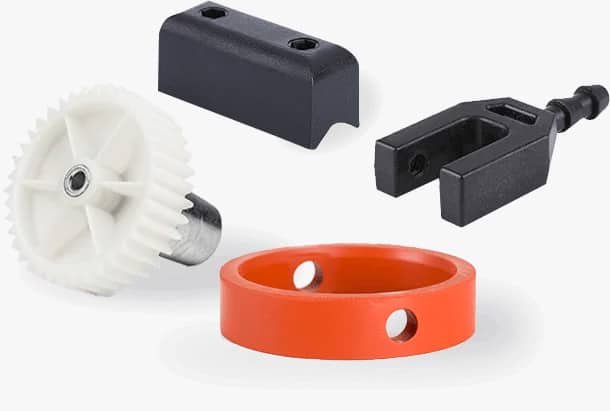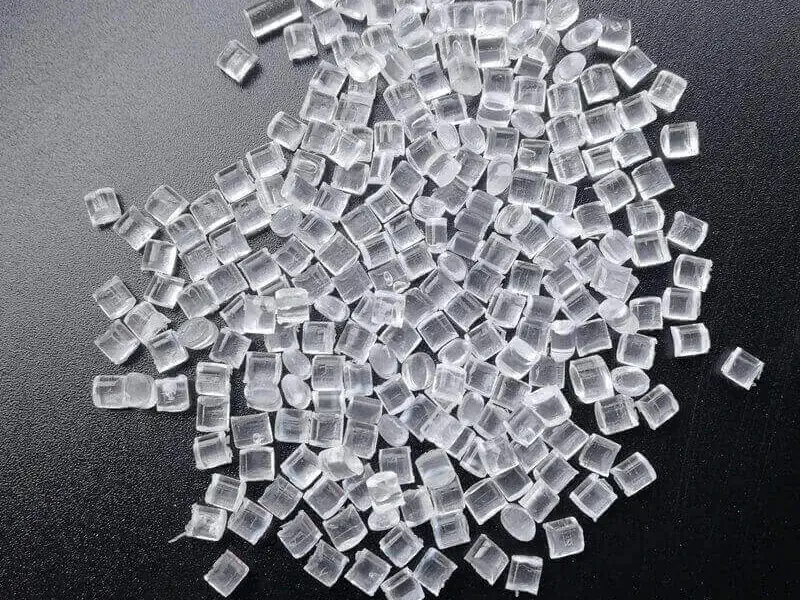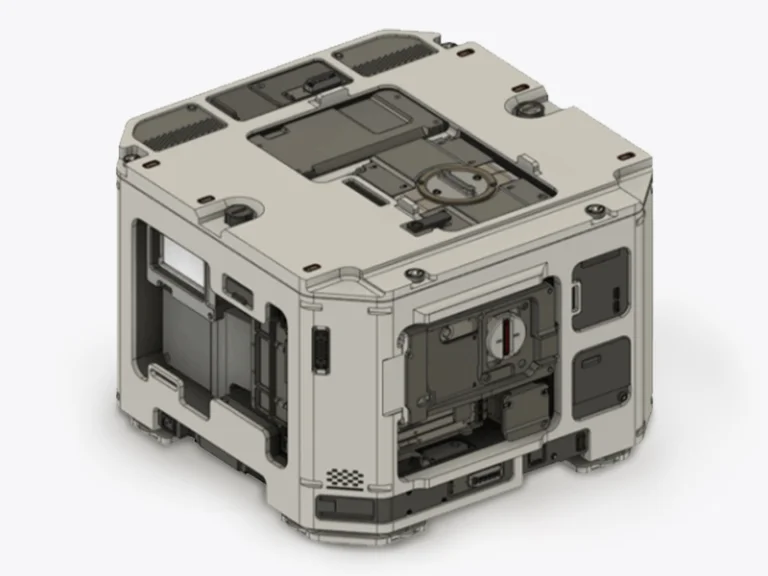Polycarbonate injection molding stands out as a versatile and efficient process for creating high-performance plastic parts. This article provides an exploration of the polycarbonate injection molding process, including material characteristics, design guidelines, processing parameters, technology innovations, advantages and challenges, and prominent applications.
What is Polycarbonate Material?
Polycarbonate (PC) is a robust, transparent thermoplastic favored for its high impact resistance, optical clarity, and thermal stability. It stands out as lighter than glass but with far superior toughness, making it ideal for precision molded components requiring strength and clarity. Various modified forms of PC exist to suit specific manufacturing or end-use requirements, including:
- Optical-grade PC
- Flame-retardant PC
- UV-stabilized PC
- Glass fiber reinforced PC
- Scratch-resistant coated PC
- UV-blocking PC
- Easy-processability modified PC
- Filled PC (e.g., with glass or stainless steel fibers)
- Alloy PC (such as PC/ABS, PC/PBT, PC/PET)
Polycarbonate Injection Molding Design Guide
Optimizing design for polycarbonate injection molding is important. Key design principles include:
Maintain Uniform Wall Thickness
When embarking on polycarbonate plastic molding projects, engineers must prioritize features that accommodate PC’s high viscosity and shrinkage rate of 0.5-0.7%. Start with uniform wall thicknesses between 1mm and 3.8mm to ensure even flow during the polycarbonate molding process and prevent warping in the final molded polycarbonate part. Thinner walls facilitate faster cooling but demand precise control to avoid incomplete fills, while thicker sections risk sink marks.
Design Ribs and Bosses
Ribs and bosses should be designed thoughtfully in PC injection molding. Rib thickness should be limited to 50 to 60 percent of the adjacent wall thickness to enhance stiffness while avoiding cosmetic defects. Incorporate generous radii of at least 0.125 inches (3 millimeters) at corners to distribute stress evenly and reduce the likelihood of cracking under impact, which is a common concern in polycarbonate injection applications. In addition to thickness and radius considerations, proper draft angles are also critical for ribs and bosses.
Optimize Gate Placement
Opt for edge or submarine gates in visible areas to minimize marks, and use mold flow analysis software early in the design phase to simulate resin flow and predict potential issues like air traps or weld lines.
Proper Surface Finishes
Surface finishes can range from high gloss for optical clarity to textured for improved grip. It is important to always consider the scratch-prone nature of polycarbonate. Incorporating protective coatings during the molding process can help extend the longevity of the part.
Advantages of Polycarbonate Injection Molding
1. Quicker Cycle Time
Polycarbonate injection molding is significantly faster than other methods such as vacuum forming or machining. Faster cycle times mean higher production volumes within a shorter time frame, which reduces the cost per part and increases manufacturing efficiency.
2. Precise Tolerances
This process enables the production of parts with very tight and consistent dimensional tolerances, typically within ±0.1 mm. The molds are carefully designed and machined ensuring that the molded polycarbonate parts meet exact specifications.
3. Wide Range of Part Sizes
Injection molding accommodates a vast range of part sizes. While the smallest parts are limited by the material’s viscosity and ability to fill small mold features, the maximum size depends on the injection molding machine and mold capacity.
4. Excellent Part-to-Part Repeatability
The polycarbonate molding process delivers high repeatability, producing consistent parts throughout long production runs. Statistical process control helps maintain quality by minimizing variations due to machine wear or material inconsistencies.
5. Ideal for Mass Production
Injection molding excels in mass manufacturing. This scalability significantly lowers the cost per part, making polycarbonate injection molding ideal for high-volume applications.
6. Superior Surface Finish and Optical Clarity
Injection molds can be polished to a mirror-like smoothness, transferring this finish to parts that demand optical clarity, such as automotive headlight lenses or electronic display covers.
7. Efficient Use of Raw Materials
Unlike subtractive processes, injection molding uses only the material necessary to fill the mold, minimizing waste. The residual material in runners can often be recycled, further improving material efficiency and environmental sustainability.
8. Reduced Labor Costs through Automation
The injection molding process is highly automated, requiring limited human involvement during production. This reduces labor costs compared to processes like machining, contributing to the overall competitiveness of polycarbonate plastic injection molding.
9. Capability for Complex Designs
With proper design for manufacturing (DFM) principles, injection molding can produce complex parts with intricate geometries, using multi-material overmolding and insert molding techniques to enhance part functionality.

Disadvantages of Polycarbonate Injection Molding
1. High Initial Mold Cost
The upfront expenses for mold design and fabrication are significant. This high tooling investment makes polycarbonate injection molding less economical for low-volume production or prototyping stages.
2. High Raw Material Cost
Polycarbonate resin is relatively expensive compared to other thermoplastics.
3. Complexity in Processing
Polycarbonate has a high melt viscosity, which complicates the injection molding process, especially for thin-walled or intricate parts.
Polycarbonate Injection Molding Processing Guide
Mastering the polycarbonate injection molding process demands attention to detail, from material preparation to machine settings.
Material Pre Dring
As PC’s hygroscopic nature can lead to bubbles or weak spots if moisture exceeds 0.02%. The polycarbonate materials need to be dry at 100-120°C for 3-4 hours to keep moisture under 0.02%.
Polycarbonate Injection molding Parameters
- Barrel Temperature: 250°C to 320°C based on part thickness and grade.
- Mold Temperature: 80°C to 174°C, typically 150°C to 174°C for optical-grade parts to ensure clarity and reduce internal stress.
- Injection Pressure: 70 to 100 MPa depending on part complexity and size.
- Injection Speed: Variable; slower speeds for thin-walled, small-gate parts to prevent burn marks or flow lines, faster speeds for larger gates.
- Screw Speed: Controlled around 30 to 60 rpm to ensure uniform melting without degradation.
- Cooling Time: Adjusted per wall thickness and mold temperature to solidify parts completely and minimize residual stresses.
Polycarbonate Injection Molding Techniques
To achieve the best results, different molding techniques can be applied depending on the part requirements, design complexity, and end-use applications.
Optical Molding
This technique produces high-precision optical components without the need for polishing. It replicates detailed optical surfaces directly from polished molds, ideal for lenses and light-guiding parts. Optical molding demands careful process control due to polycarbonate’s unique properties.
Thin Wall Molding
Thin wall molding creates lightweight, thin parts by using machines and molds designed for higher injection pressures. It reduces material usage and cycle times but requires careful design to overcome challenges posed by polycarbonate’s viscosity.
Water-Assisted Injection Molding (WAIM)
WAIM uses high-pressure water to hollow out parts, producing uniform wall thickness and smooth surfaces. Benefits include reduced material and tooling costs, improved cooling, and the ability to mold larger hollow sections. Proper water drainage and part design are crucial.
Two-Component (Multi-Material) Molding
This method combines two or more materials in one part using approaches like bi-injection, co-injection, overmolding, or multi-shot molding. It allows combining different hardness, colors, or properties, enhancing functionality and aesthetics.
Injection Compression Molding
A hybrid process where molten polycarbonate is injected into a partially open mold, then compressed to complete filling. It reduces internal stresses and sink marks and improves dimensional accuracy, especially useful for thick, large, or decorative parts.
Structural Foam Molding
Structural foam molding creates lightweight parts with a solid outer skin and a foam core by introducing blowing agents. This technique lowers material usage and enhances strength-to-weight ratios, suitable for large structural components requiring rigidity and insulation.
Applications of Polycarbonate Injection Molding
Polycarbonate plastic injection molding caters to a broad spectrum of applications due to its versatile properties, including:
Automotive Industry: Headlight lenses, instrument panels, and interior trims.
Medical Devices: Surgical tools and housings.
Consumer Electronics: Transparent panels, connectors, and housings.
Safety Equipment: Protective goggles, helmets, and face shields.
Household Items: Kitchenware, lighting fixtures, and transparent protective covers.
Conclusion: Choose a Polycarbonate injection molding Supplier
Jiangzhi provides advanced plastic injection molding services with a strong focus on polycarbonate injection molding. With expertise in working with polycarbonate and other engineering plastics, we deliver solutions tailored to your exact specifications. Whether you need high-strength prototypes or large-scale production, Jiangzhi ensures precision, durability, and efficiency. Contact Jiangzhi today to get a custom polycarbonate injection molding solution for your project.





